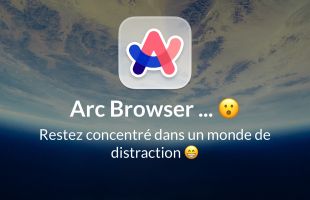
A small list of the apps I use every day, and more importantly, why use them?
Free services
Integrate maps to your sites Editable QR Code after printing Customizable short link Password generator Create images for social networks Create harmonious color palettes Unminify your code Create .gitignore files with ease Restaurant reservation system Booking software for hairdressersSummary
Hello and good morning,
This week I'm going to give you a short list of the applications I use on a daily basis, and more importantly ... why?
First of all, I'm not talking about licenses here, and even less about commercial practices. Yes, I know that in this article I'm going to talk about companies that have commercial practices that not everyone agrees with, but I'm not going to deal with that, so try to keep that in mind when reading this article.
How do I choose my tools?
Actually, I do it from a human point of view and even more from an entrepreneurial point of view, my time is the most precious thing I have, in a day I can easily finish at 10 or 11 pm.
I choose my tools according to the user experience they provide, the time they save me, and above all, as an entrepreneur and developer myself... I draw inspiration from them! So how can I make tools I'm proud of? Well, I myself have to use applications that give me the feeling I want to give users.
For some tools, in addition to being a commercial product, their designers have left the "sourcemaps" in the application in production, which allows me to see how they designed it... in this case I have even less of a problem paying for the service.
I'm part of the Apple ecosystem
On a daily basis, I use a Mac and an iPhone, but why?
Because 90% of my partners' end-customers use Apple hardware, and because I use Apple hardware myself, I can provide them with the best possible experience on this platform.
For example, where do you think my "window.navigator.share" article comes from? From the fact that on iOS doing a "classic" web share doesn't launch the Facebook app... So you have to log in to your account and that's a poor experience, nobody likes typing a password on a smartphone, nobody....
On top of that, copying and pasting on several devices is very practical when testing, yes, when I dev, I also use the phone to see the rendering (the responsive mode of browsers is good, but the feeling is not the same). I must admit that the "closed" side of the Apple is very useful (but very restrictive at times!).
Of course, I also have a Windows/Linux PC and an Android phone, so I can see what the final experience is like for users of these platforms too.
My main operating system: macOS
Why macOS? Basically, because a lot of developers are on it and good tools were born on it, even if today it's my real one, notably thanks to the advent of webapps, which are of course available on all platforms on the market.
In fact, macOS gives me access to a Unix, but also to big commercial software like Final Cut Pro or Pixelmator Pro (more on that later).
Mobile operating system: iOS
Nothing special to say, an iPhone, I use it as an everyday phone, to check the news, etc.., I use Safari much more than "native" apps, and of course I also use it to test my own sites/applications on the mobile version of Safari (Safari Desktop and Safari mobile sometimes do very different things...).
I also use an iPad for testing (in particular, because an iPad returns a macOS "user-agent" when it makes an HTTP request.
The problem is that you don't present the same interface when it's a touch screen as when the user is using a mouse....
General applications
Here I've grouped together applications that "everyone" can use - you don't necessarily have to be in tech to use them.
Music application: Spotify
Well, that's that.
Spotify is far from having the best sound quality compared to all the offerings on the market, but I'm sticking with Spotify.
But I'm sticking with Spotify. Why? It can be summed up in one sentence: "THE RECOMMENDATIONS !!!!!!!" (yeah, I caps lock, yeah).
Spotify shows how to use data in a way that's useful to the user, and that's crazy!
Let me explain: on other music streaming services, I go round in circles, there are of course the bands I already know, but beyond that, on Apple Music for example, the recommendation algorithm is mediocre ... it hasn't helped me discover anything crazy.
With Spotify, all you have to do is look at my history, and you'll realize that from one year to the next I don't listen to the same bands ... they're the ones who've helped me discover new "nuggets" ....
By the way, it's Monday as I write this article, so it's time for "Discover Weekly"?
Mail client: Hey.com
I'll come back to this one in a dedicated article, because it deserves it.
One of the problems with e-mail is that when you start receiving dozens a day, it quickly becomes unmanageable, and that's not to mention unwanted entries in databases and the receipt of May that doesn't interest you.
"With "Hey", you can easily sort new incoming e-mails, either screen them out, put them in "important" e-mails, or in newsletters, or in papers (such as invoices, receipts, etc.).
The service is particularly well done, behind a small company with 30 employees.
And the icing on the cake? sourcemaps are available on their products, which is how I discovered Turbo and Stimulus. In addition to providing a superb tool for all the developers on the planet, they show you a concrete use case in production by providing you with the source... Thank you....
A mail client, from a small company that focuses on its customers and giving them the best possible experience, at its best?
Photo editing software: Pixelmator Pro
I'm not a graphic designer, so I don't really want to go to the trouble of learning how to use Photoshop or Gimp.
(and that I could quickly get my partners' collaborators to learn).
I installed Pixelmator Pro, and 4 hours later I was already able to do a few things with it... and today? All the illustrations you see on this blog are done with it.
To go a step further, 90% of the illustrations you see at Les Frères Marchand, on the net, are done with Pixelmator Pro.
In short, $40 that I don't regret having invested, very practical, the only downside being that it only works on macOS, but hey, you can't have everything.
Very good software from a small company, I love it.
Video editing software: Final Cut Pro
Now, I know the purists are going to say "Adobe Premiere", NOOBS.
Except that I'm not a video editor either, so I do a bit of editing from time to time when I need to (and when I need to fast!).
Final Cut Pro does the job perfectly well, and Apple has understood this. That's why this kind of easy-to-use software is exclusive to their platform, because it sells Macs. If you take a look at the youtubeur Amixem, the entire fleet of editing machines is Apple... because Final Cut Pro...
If you want to see an edit I made with Final Cut Pro, check this out
Yes, it's basic, but it enables small companies to create things that would otherwise be out of their reach, and that's a beautiful thing....
There's also iMovie, which is the free light version of Final Cut Pro.
Crypto wallet: Ledger LIVE
Actually, it's more the Ledger Nano X itself.
But then, this is basically a software article.
It works, it's compatible everywhere, you can connect seamlessly to your favorite crypto wallet.
What's more, I hear Ledger likes Symfony?
Grammar and spelling checker: Druide Antidote
For the French language, it's the reference, it allows you to learn a lot about the French language (and English too, I guess, I don't have the English module).
It allows me to limit breakage when writing my articles (even if there are still some typos, let's face it).
It costs about 50 euros a year, but if, like me, you enjoy writing, it's a must-have.
Applications more specific to my business
Web framework: Symfony ?
For those of you who don't know yet (there are two of you, I think), my framework of choice is Symfony, and that's not about to change - the more time I spend on it, the more I love it.
Focus on what's important for your application and let Symfony take care of it, at worst if you need to understand how a component works (and modify it) everything is free and documented.
It's at the heart of this site, at the heart of all the projects I manage... and allows me to do what I love, building applications / sites that people want to use....
There's only one limit with Symfony, your creativity, so create.
Development environment : Jetbrains (PHPStorm)
Aie, Aie, Aie ... what fun?.
In fact, I've come to realize that among Symfony devs, PHPStorm is the benchmark - you only have to look at Symfony Cast to see that.
It's not free, it's heavy (ah, your CPU will go through the roof), but it'll save you so much time you won't be able to do without it!
Here are just a few of the features:
- Top-notch autocompletion.
- Typos correction (you know when you're tired and write "porduct" instead of "product").
- Lightning search in your code and in "vendors" or "nodes_modules".
- Git integration
- Symfony and PHP Annotation integration (now attributes) PERFECT!
In short, it's one of my other "trade secrets", allowing me to focus on what really matters: making the best software possible as a small business.
MySQL / MariaDB database explorer: Sequel Ace
Even if MySQL is being replaced by Postgres, it's still useful,
"Sequel Ace" is the sequel to "Sequel PRO", open source, functional and without the need for a PHPMyAdmin (and therefore one less attack vector).
Unfortunately, only available on macOS, remember the first paragraph?
Database explorer: TablePlus
Paid, but does a good job and above all knows how to adapt to all databases, very practical and rather powerful, I rather like this software, I haven't mastered it perfectly yet, but for the use I have of it, we're good.
As open source software, there's DBeaver
FTP / SFTP client: Cyber Duck
When I saw the name and logo, I laughed, that's it, it does the job, so I'm okay with it.
(yes, I know I outdid myself on the explanation there).
Browser: Chrome
I'm putting it last, because I don't want to give it any special publicity, it works, but I'm using it more out of compulsion than out of desire, in fact, I basically prefer Firefox, but
On macOS, Firefox is slow
When you're on Firefox, for a market that essentially runs on "Blink" or "Webkit", using anything else is like shooting yourself in the foot?
I tried, but I spent too much time coming back to Chrome to check that "it works well for 90% of users".
So I put Chrome there, but without much conviction, even though it has made a contribution to the industry (like Electron).
Conclusion
So that's a quick overview of the software I use every day.
I always choose software on the basis of what it brings me, its simplicity, so that I can draw inspiration from it to try and create software that's fun to use myself.
Have a great week?


